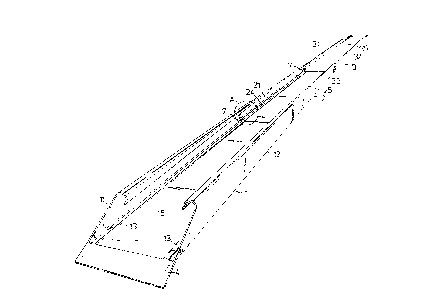Une partie des informations de ce site Web a été fournie par des sources externes. Le gouvernement du Canada n'assume aucune responsabilité concernant la précision, l'actualité ou la fiabilité des informations fournies par les sources externes. Les utilisateurs qui désirent employer cette information devraient consulter directement la source des informations. Le contenu fourni par les sources externes n'est pas assujetti aux exigences sur les langues officielles, la protection des renseignements personnels et l'accessibilité.
L'apparition de différences dans le texte et l'image des Revendications et de l'Abrégé dépend du moment auquel le document est publié. Les textes des Revendications et de l'Abrégé sont affichés :
| (12) Brevet: | (11) CA 2013637 |
|---|---|
| (54) Titre français: | AMELIORATION APPORTE A DES RAMPES DE CHARGEMENT |
| (54) Titre anglais: | IMPROVEMENT IN LOADING RAMPS |
| Statut: | Périmé et au-delà du délai pour l’annulation |
| (51) Classification internationale des brevets (CIB): |
|
|---|---|
| (72) Inventeurs : |
|
| (73) Titulaires : |
|
| (71) Demandeurs : |
|
| (74) Agent: | MARKS & CLERK |
| (74) Co-agent: | |
| (45) Délivré: | 1999-11-16 |
| (22) Date de dépôt: | 1990-04-02 |
| (41) Mise à la disponibilité du public: | 1990-10-03 |
| Requête d'examen: | 1996-10-21 |
| Licence disponible: | S.O. |
| Cédé au domaine public: | S.O. |
| (25) Langue des documents déposés: | Anglais |
| Traité de coopération en matière de brevets (PCT): | Non |
|---|
| (30) Données de priorité de la demande: | ||||||
|---|---|---|---|---|---|---|
|
An arrangement for limiting the extent to which
telescopically mounted sections can be extended is enclosed
in a chamber between each pair of sections, so as to be out
of the way of personnel handling the sections. The
arrangement comprises two mutually co-acting devices which
have the form of hollow bodies and which are intended to
engage one another when the section of a pair of sections
are extended to a maximum. The mutually facing surfaces of
the hollow bodies are preferably provided with a damping
ramp section.
Note : Les revendications sont présentées dans la langue officielle dans laquelle elles ont été soumises.
Note : Les descriptions sont présentées dans la langue officielle dans laquelle elles ont été soumises.

2024-08-01 : Dans le cadre de la transition vers les Brevets de nouvelle génération (BNG), la base de données sur les brevets canadiens (BDBC) contient désormais un Historique d'événement plus détaillé, qui reproduit le Journal des événements de notre nouvelle solution interne.
Veuillez noter que les événements débutant par « Inactive : » se réfèrent à des événements qui ne sont plus utilisés dans notre nouvelle solution interne.
Pour une meilleure compréhension de l'état de la demande ou brevet qui figure sur cette page, la rubrique Mise en garde , et les descriptions de Brevet , Historique d'événement , Taxes périodiques et Historique des paiements devraient être consultées.
| Description | Date |
|---|---|
| Inactive : CIB de MCD | 2006-03-11 |
| Le délai pour l'annulation est expiré | 2005-04-04 |
| Lettre envoyée | 2004-04-02 |
| Inactive : Lettre officielle | 2000-03-28 |
| Accordé par délivrance | 1999-11-16 |
| Inactive : Page couverture publiée | 1999-11-15 |
| Inactive : Grandeur de l'entité changée | 1999-09-08 |
| Inactive : Taxe finale reçue | 1999-08-13 |
| Préoctroi | 1999-08-13 |
| Un avis d'acceptation est envoyé | 1999-03-08 |
| Lettre envoyée | 1999-03-08 |
| Un avis d'acceptation est envoyé | 1999-03-08 |
| Inactive : Renseign. sur l'état - Complets dès date d'ent. journ. | 1999-02-17 |
| Inactive : Dem. traitée sur TS dès date d'ent. journal | 1999-02-17 |
| Inactive : Approuvée aux fins d'acceptation (AFA) | 1999-01-18 |
| Toutes les exigences pour l'examen - jugée conforme | 1996-10-21 |
| Exigences pour une requête d'examen - jugée conforme | 1996-10-21 |
| Demande publiée (accessible au public) | 1990-10-03 |
Il n'y a pas d'historique d'abandonnement
Le dernier paiement a été reçu le 1999-03-24
Avis : Si le paiement en totalité n'a pas été reçu au plus tard à la date indiquée, une taxe supplémentaire peut être imposée, soit une des taxes suivantes :
Veuillez vous référer à la page web des taxes sur les brevets de l'OPIC pour voir tous les montants actuels des taxes.
| Type de taxes | Anniversaire | Échéance | Date payée |
|---|---|---|---|
| TM (demande, 8e anniv.) - petite | 08 | 1998-04-02 | 1998-03-26 |
| TM (demande, 9e anniv.) - petite | 09 | 1999-04-02 | 1999-03-24 |
| Taxe finale - générale | 1999-08-13 | ||
| TM (brevet, 10e anniv.) - générale | 2000-04-03 | 2000-03-20 | |
| TM (brevet, 11e anniv.) - générale | 2001-04-02 | 2001-03-19 | |
| TM (brevet, 12e anniv.) - générale | 2002-04-02 | 2002-03-20 | |
| TM (brevet, 13e anniv.) - générale | 2003-04-02 | 2003-03-07 |
Les titulaires actuels et antérieures au dossier sont affichés en ordre alphabétique.
| Titulaires actuels au dossier |
|---|
| KVISTBERGA PRODUKTER AB |
| Titulaires antérieures au dossier |
|---|
| GORAN KARLSSON |